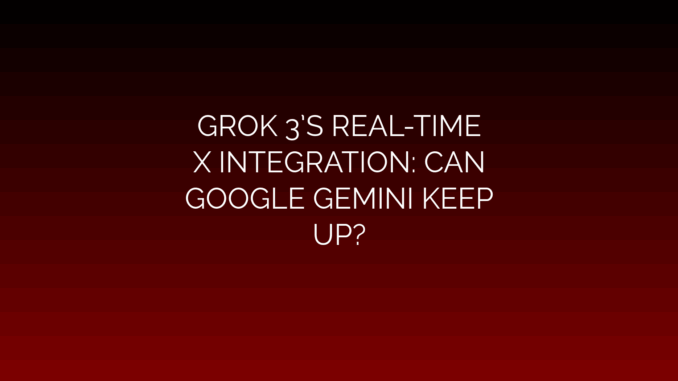
The AI Arms Race Intensifies: Grok 3’s Real-Time X Integration Challenges Google Gemini
The integration of artificial intelligence into social media is no longer speculative—it’s pivotal. Elon Musk’s Grok 3, deeply embedded in the X platform (formerly Twitter), has set a new benchmark with realtime X integration, processing live conversations, trends, and user interactions instantaneously. This innovation presents a significant challenge to rivals like Google Gemini, which operates in a more traditional, searchandresponse paradigm. As generative AI evolves beyond static queries toward dynamic, contextually aware interactions, the question arises: Can Gemini adapt quickly enough to compete in the era of realtime social intelligence?
Understanding Grok 3’s Real-Time Edge
Grok 3 leverages X’s vast, volatile data stream to deliver unparalleled contextual awareness. Unlike conventional AI, it doesn’t just analyze historical data—it thrives on the now. Key features include:
- Live Trend Synthesis: Grok identifies emerging topics on X within seconds, distilling complex conversations into digestible insights—ideal for breaking news, market shifts, or cultural moments.
- Contextual User Engagement: By accessing a user’s X activity (with consent), Grok personalizes responses based on their posts, interests, and network. This creates fluid, adaptive dialogues.
- Predictive Analytics: Observing real-time interactions allows Grok to forecast trends (e.g., viral content) faster than traditional analytics tools.
This integration positions Grok as a “socially intelligent” AI, transforming passive users into active participants in a datadriven feedback loop.
Google Gemini’s Strengths—and Limitations
Gemini excels in structured, knowledgeintensive workflows. Its integration with Google Search, Workspace, and proprietary datasets enables sophisticated tasks like code generation, multimodal analysis, and enterprisescale data processing. However, its architecture faces hurdles in social media’s chaotic realtime environment:
- Static Data Reliance: Gemini primarily draws from indexed web pages and periodic Google Search updates. While rapid, this pipeline can’t match X’s millisecond-level data flow.
- Privacy Restrictions: Google’s stringent data policies limit its access to user-specific social contexts. Gemini anonymizes inputs, sacrificing personalization depth.
- Speed vs. Depth Trade-Off: Gemini prioritizes accuracy through multi-step verification. For static queries (e.g., “Explain quantum computing”), this is ideal—but it struggles with volatile, opinion-driven conversations.
Google’s response so far has been iterative: Gemini Advanced now offers faster reasoning, and its “Live” feature taps into YouTube and Search trends. Yet, it remains a step behind Grok’s native synergy with X.
Why Real-Time Integration Is Advantageous
Grok’s realtime X integration isn’t just a feature—it’s a strategic moat. In pivotal scenarios, the immediacy matters:
- Financial Markets: Grok detects sentiment shifts from influential traders’ posts, enabling faster reactions to market-moving events than Gemini’s delayed financial summaries.
- Crisis Response: During disasters, Grok curates eyewitness reports and aid requests on X. Gemini relies on verified sources, risking delayed insights.
- Brand Management: Companies use Grok to identify PR crises (e.g., viral complaints) within minutes. Gemini’s brand tools are robust but lag in rapidly evolving situations.
User expectations compound this gap. Audiences increasingly demand AI that “understands” live discourse, not just archives.
Can Gemini Bridge the Gap?
Google possesses the resources and technical prowess to compete but needs radical shifts in strategy:
1. RealTime Data Partnerships: Integrating with platforms like Reddit, TikTok, or even X’s API could provide live social data. However, API costs and privacy regulations pose barriers. 2. OnDevice Processing: Gemini Nano’s edge computing capabilities could allow faster local analysis of userspecific social data without cloud latency. 3. AI Architecture Overhaul: Transitioning from batched data processing to eventdriven models would require reengineering Gemini’s infrastructure—a costly, multiyear effort.
Beyond engineering, Google must navigate ethical risks. Realtime analysis amplifies misinformation threats. Grok’s early errors in live events (e.g., misquoting influencers) highlight this fragility. Gemini’s caution here could become an advantage if paired with speed innovations.
The Path Forward: Adaptation or Obsolescence?
The GrokGemini rivalry transcends technical specs—it’s a clash of philosophies:
- Grok champions a tightly coupled social-AI ecosystem, betting that speed and context outweigh occasional inaccuracies.
- Gemini favors accuracy and scalability, slow to prioritize social dynamism.
For Gemini to keep pace, it must embrace “ambient intelligence”—AI that learns continuously from openended interactions, not just canned queries. Initiatives like Project Astra hint at this direction but lack Xstyle native integration.
Meanwhile, Grok’s boldness is not without risk. Dependence on X’s ecosystem could backfire if user engagement falters or regulatory scrutiny intensifies.
Conclusion: The Race Is On
Grok 3’s realtime X integration reshapes user expectations: AI must now converse, adapt, and anticipate within evershrinking windows. Google Gemini’s response will define the next phase of the AI wars. Shortterm, Grok holds the edge in social agility. However, Gemini’s infrastructure depth and ethical rigor position it for an evolved realtime approach—if it can act decisively. The victor won’t merely be the faster AI, but the one that balances speed, accuracy, and trust. As generative AI permeates daily life, its integration with human spontaneity becomes nonnegotiable. Google’s next move must acknowledge: in the age of the perpetual now, standing still is falling behind.
Leave a Reply